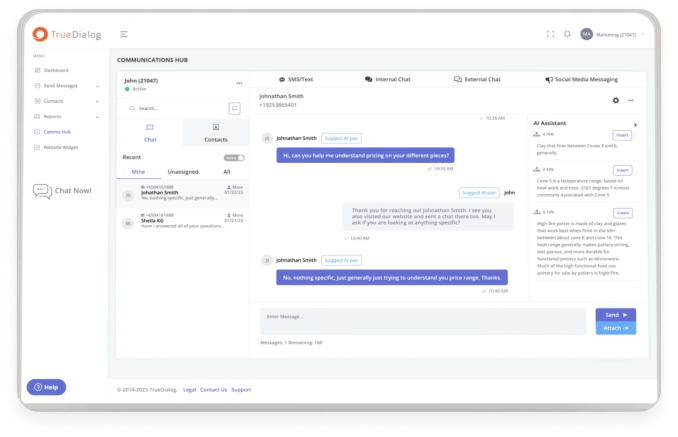Today, mobile phones serve more purposes than making and receiving calls. People use phones to store data, take photos, and share information. According to research by analysis firm Counterpoint, most people spend five or more hours on their mobile phones daily. With such an active and captive audience on mobile devices, it’s no wonder an effective marketing strategy must include a mobile approach.
Messaging apps and SMS are the most widely used and favorite apps on mobile phones. Targeting your customers through their preferred channel can positively impact your company’s retention rates.
In fact, 74% of consumers prefer messaging with a brand if a real person is texting. Marketing experts have discovered that tailored SMS marketing is a quick, easy, and cost-effective strategy for reaching their target audiences and fostering a high conversion rate.
Evolution of Marketing Channels
The past two decades have seen some big shifts in the way companies do business, particularly with the adoption of online marketing approaches. Understanding how marketing channels have changed allows business owners to make informed choices based on what works and what doesn’t for their target audience.
Until recently, outbound marketing was the prevailing marketing method, where cold calls, television and print ads, and trade shows reigned. This type of marketing outreach is expensive and, according to Hubspot, results in lower ROI than inbound marketing. Many consumers also feel it is invasive or irrelevant. Now, inbound marketing is widely used, a method of creating content to spread brand awareness and draw in prospective customers.
Advertising Moves From TV to Online
The 1990s was a significant decade in advertising technology. The internet prompted the development of new marketing channels that proved more successful and cost-effective. Television replaced print advertising, and it was the most utilized method of marketing.
In the mid-90s, search engines appeared. Since then, the number of people using the internet has increased drastically. In 1997, the term Search Engine Optimization (SEO) entered the marketing lexicon. Google developed PageRank in 1998, a site that determines how a web page ranks in search results. The term blogging developed around this time, too.
Today, brands that prioritize blogging are likely to get a good return on investment. However, you need to consistently publish informative and valuable content to generate more website traffic. So, companies should try to publish blogs at least 16 times a month.
Related: How to Send Out Mass Texts: A Guide for Businesses
Direct Marketing Channels
Direct marketing was once very effective. Direct marketing channels included targeted print newsletters, direct mail, and productive catalogs or flyers. Outbound telemarketing supplemented these marketing channels. These methods are time-consuming, expensive, and less effective than many current approaches.
These days, marketing experts using direct channels target a specific group of people who are more likely to buy their products. This segmenting approach makes direct marketing more effective and efficient.
Inbound Marketing Channels
In this era, most companies used inbound marketing to market their brands online and through social media to spread brand awareness. The inbound marketing channel lets potential consumers come to you, inviting people who are already interested in your industry to engage with your brand via social media, blogs and your website.
Here, the focus is to educate the customers since they can easily access information. Inbound marketing channels create value for the consumer rather than forcing unwanted ads on clients. This approach offers better quality clients who are most likely to make a purchase.
Social Media Marketing Channels
The early 2000’s brought the debut of social media. First came MySpace in 2003 followed in 2004 by Facebook, one of the most popular and widely used platforms today. The Twitter platform launched in 2006. However, social media and blogging were not seen as viable marketing methods until 2012.
During that year, many brands that used Facebook gained customers through their presence on the platform. This is because they took advantage of the social media community to tell people about their products and services.
Websites
The use of tablets, smartphones, and eReaders increased significantly in 2012. During this time, the number of online shoppers increased significantly, and it keeps on growing. A recent survey by PYMNTS shows that 36% of consumers are buying retail items online. This means that any brand that isn’t online today is losing many customers and sales opportunities.
Why Businesses Need to Adapt to the Evolution of Marketing Channels
Today, technology has changed how brands market their products. It has changed the playing field, and brands have to level their marketing strategies to remain in business. Technology has led to the development of new companies, making it hard to succeed. Therefore, companies have to adapt to the change in marketing channels to take advantage of them. Also, they will be able to connect with their customers and retain them.
Related: How Texting Messages Improves The Customer Service Experience
How Brands Can Leverage SMS Marketing
Text for business marketing isn’t a replacement for “junk mail” and ads in the newspaper. The true objective is to build brand awareness, loyalty, and a connection with prospective and current customers. There are a number of ways you can leverage SMS within your business.
Customer Service
You can use customer service texts to inform your customers about order confirmation and tracking updates, reservation and appointment reminders, payment confirmation, and so on. You can also use texts to send scheduled reminders to customers, such as annual pet vaccination, medical check-up, HVAC routine maintenance, and subscription expiry.
Making it even easier for you, these texts can also be triggered by external events. For instance, businesses and educational institutions can automatically send a text if there is an electricity outage or weather event closing their physical location.
Marketing
You can also send texts to market your product and services. Keeping your existing and potential consumers informed about promotions, upcoming events, and exclusive offers can significantly impact your business. Successful brands understand that sending messages to consumers is the key to attracting, retaining, and converting consumers. Add value with relevant offers while staying front of mind with your recipients.
Surveys and Polls
If you want to succeed in business, it’s essential to get feedback from consumers about your products and services. This makes your customers feel valued since they’ll see that you are interested in what they think about your products, rather than seeing them as a transation. Also, you can use the information to shape your future products and services effectively.
Sales
Texts have higher response rates compared to social media or mobile ads. So, if you haven’t used this channel already, talk to experts to help you start using it for sales as soon as possible.
You can use mass text messages to inform your customers about an upcoming sale, discount, event or in-stock product they were looking for. This way, your customers will feel important, thus becoming loyal to your brand. Send your customers a short promotional message and include the price to attract more customers. Don’t forget to include a link to your site.
What You Should Know
Text is More Reliable Than Email
The open rate of SMS is 99%, compared to an estimated 28-33% of emails. When you inform your customers about promotion via text, they are more likely to open it than when you do it via email. Also, text messaging campaigns are cost-effective, with higher return rates than email campaigns.
SMS Has Higher Engagement
There is no doubt that SMS has high read and open rates. Although most people own smartphones and are online more often, a person still needs an internet connection to access email. On the other hand, texts don’t require an internet connection, and they are delivered immediately, making them more effective.
Take Action Today
If you haven’t considered using text for business marketing, you miss out on a much broader audience and market opportunities. As you have seen, customers are more likely to engage with a brand that uses text messages to connect to them. Also, you are missing out on the opportunity to reach your customers where they are and experience a high conversion success rate.
In the modern era, customers are looking for immediate satisfaction. Therefore, you need to use text to build customer trust and provide a better experience to enjoy lifetime loyalty.
At TrueDialog, we will help you boost customer engagement with text messages. Contact us today and let us help you.





